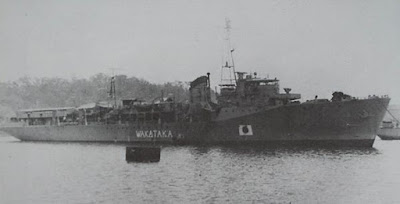 |
| IJN Wakataka, later renamed to be RSS Singapura |
The British Royal Navy (RN) gave Singapore two ships to start its navy. One was the RSS (Republic of Singapore Ship) Panglima, which was a motorised patrol boat, and the RSS Singapura, which became the official headquarters of the Republic of Singapore Navy (RSN). These two vessels served as Singapore's sea defenders in the early years of independence.
While the RSS Singapura had a short service with the Singapore navy (serving 2-3 years as a training vessel before being scrapped in 1968), it had a storied past.
The RSS Singapura was formerly the IJN (Imperial Japanese Navy) Wakataka. Its function was that of the Hatsutaka class of minelayers. Launched on 12 July 1942, IJN Wakataka took part in the invasion of North Borneo, the Dutch East Indies (Indonesia) and Papua New Guinea. In addition to mining duties, IJN Wakataka served as a troop carrier and an anti-aircraft escort.
As the Pacific war turned for the worst, its mine-laying duties were changed to anti-submarine ones. However, it unsuccessfully engaged American submarines on three occasions before being attacked on two other occasions by Allied submarines. The latter attack (near Sumbawa) resulted in the death of 20 crew. She was repaired partially and remained on patrol duty till the end of the war.
In 1947, she was given to the RN as a prize of war and renamed HMMS (His Majesty Malayan Ship) Laburnum. She was discontinued from active service in 1956 before being handed over to Singapore in 1966.
While the RSS Singapura is no more, it is good to be reminded that the RSN once had a relic fleet. It is now a modern navy. In memory of Singapore's first naval vessel, Changi Naval Base was renamed RSS Singapura Changi Naval Base in 2017.
Comments